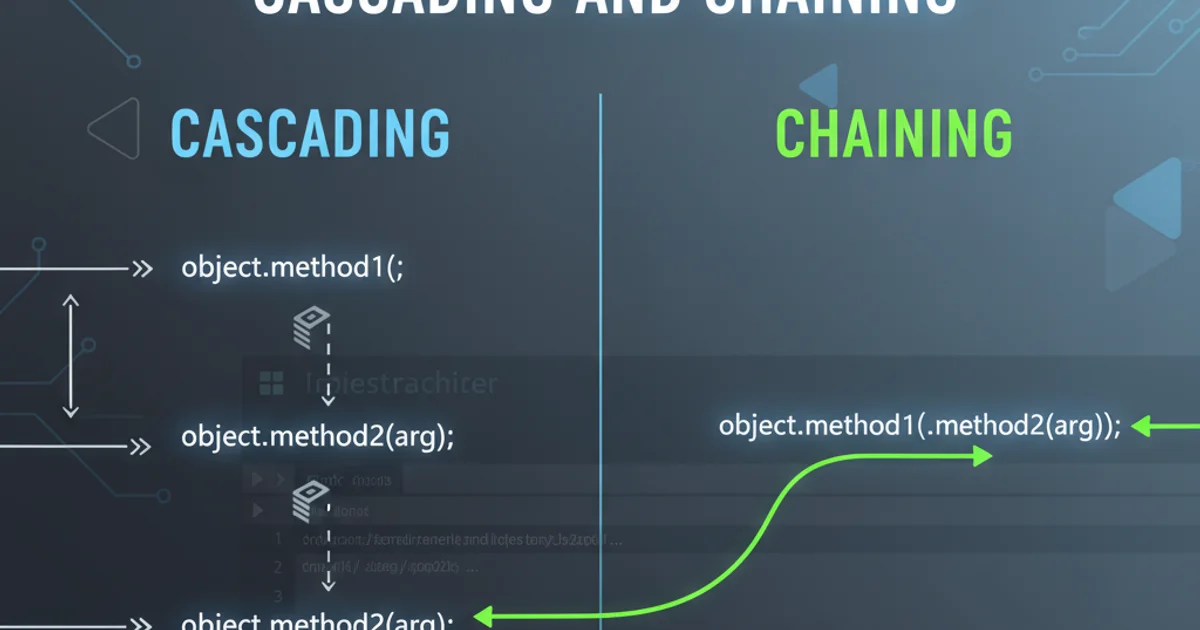what is the difference between cascading and chaining
Categories:
Cascading vs. Chaining: Understanding Method Invocation Patterns

Explore the distinct concepts of method cascading and method chaining in programming, their benefits, and how they enhance code readability and expressiveness across languages like C#, Java, and JavaScript.
In object-oriented programming, how you invoke multiple methods on an object can significantly impact code readability and maintainability. Two common patterns for sequential method calls are cascading and chaining. While often used interchangeably, they represent subtly different approaches to achieving fluent interfaces. Understanding their distinctions is crucial for writing clean, expressive, and efficient code.
What is Method Chaining?
Method chaining, also known as a 'fluent interface,' is a design pattern where methods return the current object instance (this in JavaScript/Java, this in C#) after performing an operation. This allows subsequent methods to be called directly on the result of the previous method call, forming a 'chain' of operations. It's particularly popular in libraries like jQuery, LINQ, and various builder patterns.
class Calculator {
constructor(value = 0) {
this.result = value;
}
add(num) {
this.result += num;
return this; // Returns the instance for chaining
}
subtract(num) {
this.result -= num;
return this; // Returns the instance for chaining
}
multiply(num) {
this.result *= num;
return this; // Returns the instance for chaining
}
getResult() {
return this.result;
}
}
const calc = new Calculator(10);
const finalResult = calc.add(5).subtract(2).multiply(3).getResult();
console.log(finalResult); // Output: 39
JavaScript example of method chaining
public class StringBuilderExample
{
public static void Main(string[] args)
{
// StringBuilder methods return the StringBuilder instance, enabling chaining
System.Text.StringBuilder sb = new System.Text.StringBuilder();
sb.Append("Hello")
.Append(" ")
.Append("World!")
.AppendLine(" This is a chained call.");
Console.WriteLine(sb.ToString());
}
}
C# StringBuilder demonstrating method chaining
What is Method Cascading?
Method cascading, while similar in appearance to chaining, has a distinct difference in its underlying mechanism. In cascading, a single object is passed to a series of functions or methods, each of which performs an operation on that object. Unlike chaining, the methods themselves do not necessarily return the object instance. Instead, the object is explicitly referenced for each operation. Some languages, like Smalltalk and Dart, have native syntax for cascading, allowing multiple operations on the same object without repeatedly naming the object.
// Java doesn't have native cascading syntax like Smalltalk/Dart,
// but the concept can be illustrated with a builder pattern that doesn't return 'this'
// (though most Java builders *do* chain).
// For a true cascade, you'd typically pass the object to external functions.
// Example of a 'cascading-like' approach without explicit 'this' returns (less common in Java):
public class UserBuilder {
private String name;
private int age;
public void withName(String name) {
this.name = name;
}
public void withAge(int age) {
this.age = age;
}
public User build() {
return new User(name, age);
}
}
// Usage (not a true cascade, but shows separate calls on the same object):
UserBuilder builder = new UserBuilder();
builder.withName("Alice");
builder.withAge(30);
User user = builder.build();
// A more direct 'cascading' example would be if a language allowed:
// builder
// ..withName("Alice")
// ..withAge(30)
// .build(); // Dart syntax for cascading
Java example illustrating the concept of cascading (without native syntax)
Key Differences and When to Use Each
The primary distinction lies in the return value of the methods. Chaining relies on methods returning the object itself, enabling subsequent calls. Cascading, in its purest form, allows multiple operations on an object without the methods needing to return anything specific for the cascade to continue, often facilitated by language-level syntax. Most fluent APIs you encounter in C#, Java, and JavaScript are implementations of method chaining.
flowchart TD
A[Start]
subgraph Method Chaining
B(Object Instance) --> C{Method1() returns Object}
C --> D{Method2() returns Object}
D --> E{Method3() returns Object}
E --> F[Final Result]
end
subgraph Method Cascading (Conceptual)
G(Object Instance) --> H{Method1() operates on Object}
G --> I{Method2() operates on Object}
G --> J{Method3() operates on Object}
J --> K[Final Result]
end
A --> B
A --> G
style B fill:#f9f,stroke:#333,stroke-width:2px
style G fill:#ccf,stroke:#333,stroke-width:2px
linkStyle 0 stroke-width:2px,fill:none,stroke:green;
linkStyle 1 stroke-width:2px,fill:none,stroke:blue;Conceptual difference between Method Chaining and Method Cascading
JavaScript (Chaining)
const element = document.createElement('div'); element.classList.add('my-class').setAttribute('id', 'my-id').textContent = 'Hello'; document.body.appendChild(element);
C# (Chaining)
var list = new List
Java (Chaining)
import java.util.stream.Collectors; import java.util.Arrays;
List